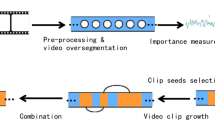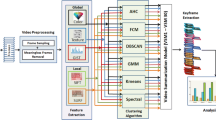Abstract
Although lots of the prior works have been proposed to solve the representative selection problem of video summarization, the main difficulty is still left for determining the optimal representatives’ number of the raw videos that are not annotated. In this paper, we propose an unsupervised video summarization method by motion-based frame selection and a novel clustering validity indexes to determine the optimal representatives of the original video. The proposed framework segments shots and selects candidate frames by evaluating their forward and backward motion and can automatically select representatives to highlight all the significant visual properties. Shots are segmented uniformly and the frame with the largest motion is extracted in each segmentation to form the video candidate frame subset. Then Affinity Propagation combined with the validity index is used to automatically select the optimal representatives from the candidate frame subset. Our experimental result on several benchmark datasets demonstrates the robustness and effectiveness of our proposed method.



Similar content being viewed by others
References
Bezdek JC (1998) Some new indexes of cluster validity. IEEE Trans Syst Man Cybern 28(3):301–315
Bharill N (2014) Enhanced cluster validity index for the evaluation of optimal number of clusters for Fuzzy C-Means algorithm. IEEE International Conference on Fuzzy Systems, p 1526–1533
Calinski T (1974) A dendrite method for cluster analysis. Communications in Statistics 3(1):1–27
Davies DL (1979) A cluster separation measure. IEEE Trans Pattern Anal Mach Intell 1(2):224–227
Dimitriadou E (2002) An examination of indexes for determining the number of cluster in binary data sets. Psychometrika 67(1):137–160
Dudoit S (2002) A prediction-based resampling method for estimating the number of clusters in a dataset. Genome Biol 3(7):1–21
Frey BJ (2007) Clustering by passing messages between data points. Science 315:972–976
Gygli M (2014) Creating summaries from user videos. European Conference on Computer Viision (ECCV), p 505–520
Hong R (2016) Multi-View Object Retrieval via Multi-Scale Topic Models. IEEE Trans Image Process 25(12):5814–5827
James C (2016) The generalized C index for internal fuzzy cluster validity. IEEE Trans Fuzzy Syst 24(6):1500–1512
Kapp AV, Tibshirani R (2007) Are clusters found in one dataset present in another dataset? Biostatistics 8(1):9–31
Lin P-L (2016) An efficient validity index method for datasets with complex-shaped clusters. International Conference on Machine Learning and Cybernetics (ICMLC), p 2160–1348
Liu X (2015) Event-based media enrichment using an adaptive probabilistic hypergraph model. IEEE Transactions on Cybernetics 45(11):2461–2471
Luo C (2016) Image classification by selective regularized subspace learning. IEEE Trans Multimedia 18(1):40–50
Ma M (2017) Nonlinear kernel sparse dictionary selection for video summarization. Proceeding of the IEEE International Conference on Multimedia and Expo (ICME), p 637–642
Mahasseni B (2017) Unsupervised video summarization with adversarial LSTM networks. IEEE Conference on Computer Vision and Pattern Recognition (CVPR), p 2982–2991
Meng J (2018) Video summarization via Multiview representative selection. IEEE Trans Image Process 27(5):2134–2145
Panda R (2017) Weakly supervised summarization of web videos. IEEE International Conference on Computer Vision (ICCV), p 3677–3686
Rousseeuw P (1987) Silhouettes: a graphical aid to the interpretation and validation of cluster analysis. J Comput Appl Math 20(1):53–65
Rui XU (2012) A comparison study of validity indices on swarm-intelligence-based clustering. IEEE Trans Syst Man Cybern 42(4):1243–1256
Said AB (2017) Cluster validity index based on Jeffrey divergence. Pattern Anal Applic 20(1):21–31
Song Y (2015) TVSum: Summatizing Web Video Using Titles, IEEE Conference on Computer Vision and Pattern Recognition (CVPR), p 5179–5187
Tasdemir K (2011) A validity index for prototype-based clustering of data sets with complex cluster structures. IEEE Trans Syst Man Cybern 41(4):1039–1053
Varini P (2017) Personalized egocentric video summarization of cultural tour on user preferences input. IEEE Trans Multimedia 19(12):2832–2844
Wang M (2012) Event driven web video summarization by tag localization and key-shot identification. IEEE Trans Multimedia 14(4):975–985
Wang M (2013) View-based discriminative probabilistic modeling for 3D object retrieval and recognition. IEEE Trans Image Processing 22(4):1395–1407
Wang M (2016) Scalable semi-supervised learning by efficient anchor graph regularization. IEEE Trans Knowl Data Eng 28(7):1864–1877
Wang M (2017) Learning on big graph: label inference and regularization with anchor hierarchy. IEEE Trans Knowl Data Eng 29(5):1101–1114
Youtube statistics. https://www.youtube.com/yt/about/press/. Accessed 2018 May 30
Zhang K (2016) Summary transfer: exemplar-based subset selection for video summarization. IEEE Conference on Computer Vision and Pattern Recognition (CVPR), p 1059–1067
Zhang Y (2017) Motion-state-adaptive video summarization via spatiotemporal analysis. IEEE Trans Circuits Syst Video Techn 27(6):1340–1352
Zhao Y (2016) Visual summarization of image collections by fast RANSAC. Neurocomputing 172:48–52
Zheng Y (2017) Driver types and their behaviors within a high level of pedestrian activity environment. The International Journal of Transportation Research 9(1):1–11
Zhou S (2011) Comparative study on method for determining optimal number of clusters based on affinity propagation clustering. Computer Science 38(2):225–228
Acknowledgements
This work was partially supported by National Key R&D Program of China, No. 2017YFC0820604; Anhui Provincial Natural Science Foundation, No. 18808085QF188 and the National Nature Science Foundation of China under Grant No. 61502138, Grant No. 61702156, Grant No. 61472116, and Grant No. 61471154.
Author information
Authors and Affiliations
Corresponding author
Additional information
Publisher’s note
Springer Nature remains neutral with regard to jurisdictional claims in published maps and institutional affiliations.
Rights and permissions
About this article
Cite this article
Zhao, Y., Guo, Y., Sun, R. et al. Unsupervised video summarization via clustering validity index. Multimed Tools Appl 79, 33417–33430 (2020). https://doi.org/10.1007/s11042-019-7582-8
Received:
Revised:
Accepted:
Published:
Issue Date:
DOI: https://doi.org/10.1007/s11042-019-7582-8




